German New Guinea
German New Guinea (German: Deutsch-Neuguinea) consisted of the northeastern part of the island of New Guinea and several nearby island groups and was the first part of the German colonial empire. The mainland part of the territory, called Kaiser-Wilhelmsland, became a German protectorate in 1884. Other island groups were added subsequently. New Pomerania, the Bismarck Archipelago, and the northern Solomon Islands were declared a German protectorate in 1885; the Caroline Islands, Palau, and the Mariana Islands were bought from Spain in 1899; the protectorate of the Marshall Islands was bought from Spain in 1885 for $4.5 million by the 1885 Hispano-German Protocol of Rome; and Nauru was annexed to the Marshall Islands protectorate in 1888.
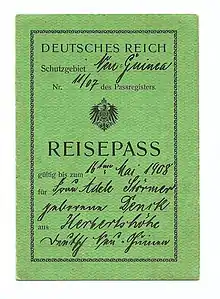
German New Guinea Deutsch-Neuguinea (German) | |||||||||||||||||
|---|---|---|---|---|---|---|---|---|---|---|---|---|---|---|---|---|---|
| 1884-1914 | |||||||||||||||||
 Coat of arms
| |||||||||||||||||
Anthem: Heil dir im Siegerkranz | |||||||||||||||||
.png.webp) German New Guinea in 1914 before the outbreak of World War I | |||||||||||||||||
| Status | German colony | ||||||||||||||||
| Capital | Herbertshöhe(1884-1910) Simpsonhafen (1910-1914) | ||||||||||||||||
| Common languages | German (official), Austronesian languages, Papuan languages, German creoles | ||||||||||||||||
| Emperor | |||||||||||||||||
• 1884-1888 | William I | ||||||||||||||||
• 1888-1914 | William II | ||||||||||||||||
| Governor | |||||||||||||||||
• 1884-1887 | Gustav von Oertzen | ||||||||||||||||
• 1901-1914 | Albert Hahl | ||||||||||||||||
| Historical era | German colonisation in the Pacific Ocean | ||||||||||||||||
| 3 November 1884 | |||||||||||||||||
| 28 June 1919 | |||||||||||||||||
| Area | |||||||||||||||||
| 1913 | 247,281 km2 (95,476 sq mi) | ||||||||||||||||
| Currency | Goldmark | ||||||||||||||||
| ISO 3166 code | PG | ||||||||||||||||
| |||||||||||||||||
| Today part of | Papua New Guinea Micronesia Palau Marshall Islands Northern Mariana Islands Nauru Solomon Islands | ||||||||||||||||
Part of a series on the |
|---|
| History of Papua New Guinea |
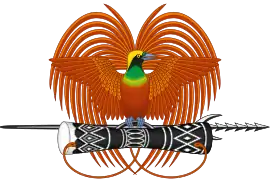 |
Following the outbreak of the First World War in 1914, Kaiser-Wilhelmsland and nearby islands fell to Australian forces, while Japan occupied most of the remaining German possessions in the Pacific. The mainland part of German New Guinea, the Bismarck Archipelago and the North Solomon Islands are now part of Papua New Guinea. The Micronesian islands of German New Guinea are now governed as the Federated States of Micronesia. The Marshall Islands, Nauru and Palau are independent countries.
The islands to the east of Kaiser-Wilhelmsland, on annexation, were renamed the Bismarck Archipelago (formerly the New Britannia Archipelago) and the two largest islands renamed Neupommern ("New Pomerania", today's New Britain) and Neumecklenburg ("New Mecklenburg, now New Ireland).[1] Due to their accessibility by water, however, these outlying islands were, and have remained, the most economically viable part of the territory.
With the exception of German Samoa, the German islands in the Western Pacific formed the "Imperial German Pacific Protectorates". These were administered as part of German New Guinea and included the German Solomon Islands (Buka, Bougainville, and several smaller islands), the Carolines, Palau, the Marianas (except for Guam), the Marshall Islands, and Nauru. The total land area of German New Guinea was 249,500 square kilometres (96,300 sq mi).[2]
History
Early German South Pacific presence
The first Germans in the South Pacific were probably sailors on the crew of ships of the Dutch East India Company: during Abel Tasman's first voyage, the captain of the Heemskerck was one Holleman (or Holman), born in Jever in northwest Germany.[3][4]
Hanseatic League merchant houses were the first to establish footholds in the South Pacific: Johann Cesar Godeffroy & Sohn of Hamburg, headquartered at Samoa from 1857, operated a South Seas network of trading stations especially dominating the copra trade and carrying German immigrants to various South Pacific settlements;[5][6][7] in 1877 another Hamburg firm, Hernsheim and Robertson, established a German community on Matupi Island, in Blanche Bay (the north-east coast of New Britain) from which it traded in New Britain, the Caroline, and the Marshall Islands.[8][9] By the end of 1875, one German trader reported: "German trade and German ships are encountered everywhere, almost at the exclusion of any other nation".[10]
German colonial policy under Bismarck
In the late 1870s and early 1880s, an active minority, stemming mainly from a right-wing National Liberal and Free Conservative background, had organised various colonial societies all over Germany to persuade Chancellor Bismarck to embark on a colonial policy. The most important ones were the Kolonialverein of 1882 and the Society for German Colonization (Gesellschaft für Deutsche Kolonisation) founded in 1884.[11] The reasons for Bismarck's lack of enthusiasm when it came to the subject of Germany's colonial possessions is reflected in his curt response in 1888 to the procolonial, expansionist remarks of Eugen Wolf, reflected in the latter's autobiography. After Bismarck had patiently listened to Wolf enthusiastically laying out his plans that he sought to pitch employing several illustrative maps, Bismarck finally interrupted his monologue:
Your map of Africa there is very nice I have to admit. But you know, my map of Africa is here ... in Europe. You see here is Russia, over there is [..] France. And us, we are here – right in the middle between those two. That's my map of Africa.[12]
Despite his personal objections, it was Bismarck himself who eventually organised the acquisition of much of what would become the German colonial empire. The very first attempts at the new policy came in 1884 when Bismarck had to put German trading interests in southwestern Africa under imperial protection.[13] Bismarck told the Reichstag on 23 June 1884 of the change in German colonial policy: annexations would now proceed but by grants of charters to private companies.[14]
Australian aspiration and British disinterest
The edition of 27 November 1882 of the Augsburger Allgemeine Zeitung carried an article which the Colonial Secretary of the British colony of New South Wales drew to the attention of the editor of the Sydney Morning Herald and, on 7 February 1883, the paper published a summary of the article under the heading "German annexation of New Guinea".[15] The argument lifted from the German paper began by stating that New Guinea fell into the Australian sphere but had been neglected; although the Portuguese had explored in the 16th century, it was the Dutch from the 17th century "who seemed better satisfied with the country than other European nations had been" but they had over-reached themselves and had fallen back towards Java, Sumatra and Celebes. Recent explorations had given the basis for reconsideration: it "is considered useful by geology and biology people as holding in its forests the key to solve problems... a profitable field for cultivation" but London had only sent missionaries to save souls. "As we Germans have learnt a little about conducting colonial policy, and as our wishes and plans turn with a certain vivacity towards New Guinea... according to our opinion it might be possible to create out of the island a German Java, a great trade and plantation colony, which would form a stately foundation stone for a German colonial kingdom of the future."
The publication of the Sydney Morning Herald article caused a sensation and not just in the colony of New South Wales: over the border, in the British colony of Queensland[16] where the shipping lanes of the Torres Strait and the beche-de-mer trade were of commercial significance.[17] The Queensland Premier, Sir Thomas McIlwraith who led a political party "considered to represent the interests of the plantation owners in Queensland",[16] drew it to the attention of the Queensland Governor together with the general situation in New Guinea and urged annexation of the island.[18] He also instructed the London Agent for Queensland to urge the Imperial Colonial Office to an act of annexation.[19]
"Impatient with the lack of results from this procedure" Premier McIlwraith on his own authority ordered a Queensland Police Magistrate in March 1883 to proclaim the annexation on behalf of the Queensland government[18] of New Guinea east of the Dutch boundary at 141E.[20] When news of this reached London, the Secretary of State for the Colonies, Lord Derby promptly repudiated the act.[1][18] When the matter came before Parliament, Lord Derby advised that the British Imperial Government “were not ready to annex New Guinea in view of its vast size and unknown interior, the certainty of native objections and administrative expense”.[21]
German New Guinea Company
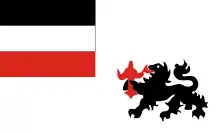
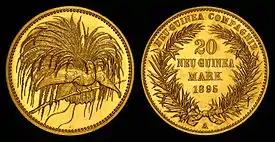
On his return to Germany from his 1879–1882 Pacific expedition, Otto Finsch joined a small, informal group interested in German colonial expansion into the South Seas led by the banker, Adolph von Hansemann. Finsch encouraged them to pursue the founding of a colony on the north-east coast of New Guinea and the New Britain Archipelago even providing them with an estimate of the costs of such a venture.[22]
On 3 November 1884, under the auspices of the Deutsche Neuguinea-Compagnie (New Guinea Company), the German flag was flown over Kaiser-Wilhelmsland, the Bismarck Archipelago and the German Solomon Islands.
Albert Hahl (1868–1945) joined the German Colonial Office in 1895 and until 1914 played a major part in New Guinea's administration. He was an imperial judge at Herbertshoehe (1896–98), deputy governor of New Guinea (1899–1901), and governor (1902–14) As a judge he made three reforms: the appointment of 'luluais' [village chiefs], attempts to integrate the Tolais people into the European economy, and the protection of village lands, which led him to recommend the ending of all alienation of indigenous land. After 1901 Hahl attempted to apply his system to the whole of New Guinea, and although his success was limited, exports rose from one million marks in 1902 to eight million in 1914. He was forced to retire because of disagreements with Berlin officials, and became an active writer on New Guinea and was a leader in German colonial societies between the wars.[23]
Lutheran and Catholic missions
By the mid-1880s German church authorities had devised a definite program for missionary work in New Guinea and assigned it to the Rhenish Mission, under the direction of Friedrich Fabri (1824–91), a Lutheran. The missionaries faced extraordinary difficulties, including repeated sickness, psychological and sometimes violent tensions and fights between the colonial administration and the locals. The later, at first, rejected European customs and norms of social behaviour, with few embracing Christianity. In 1921, the Rhenish Mission territory was handed over to the United Evangelical Lutheran Church of Australia.[24]
Missionaries sponsored by the Catholic Church in Germany had better resources and influence, and proved more successful. They put more emphasis on tradition and less on modernisation, and were more in line with the local's world-views and traditions. European morality and discipline were often adopted, as were notions of dignity and prestige.[25]
Table: German Mission societies in New Guinea[26]
| German Name | English | Latin | Abbreviation |
|---|---|---|---|
| Liebenzeller Mission, (China-Inland-Mission) | Liebenzell Mission | - | CIM |
| Maristen, Gesellschaft Mariens | Marist Mission, Marists | Societas Maristae | SM |
| Linked to German Wesleyan Churches | Methodist Mission, Australasian Methodist Mission Society, Wesleyan Society, Methodist Missionary Society of Australasia | - | - |
| Kongregation der Missionare vom Heiligsten Herzen Jesu, Hiltruper Mission, Herz-Jesu-Mission | Mission of the Most Sacred Heart of Jesus, Sacred Heart Mission, Holy Heart of Jesus | Congregatio Missionariorum Sacratissimi Cordis Jesu | MSC |
| Neuendettelsauer Mission, Gesellschaft für Innere und Äußere Mission im Sinne der Lutherischen Kirche e.V. | Neuendettelsau Mission, Lutheran Mission Finschhafen | - | ND |
| Rheinische Mission, Barmer Mission | Rhenish Mission | - | - |
| Steyler Mission, Gesellschaft des göttlichen Wortes, (Kapuziner Mission) | Society of the Divine Word | Societas Verbi Divini | SVD |
| Missionsgesellschaft vom Heiligen Geist, Spiritaner, Väter vom Heiligen Geiste | Holy Spirit Fathers, Spiritans, Congregation of the (Servants of) the Holy Ghost. | Congregatio Sancti Spiritus | CSSp |
Imperial German Pacific protectorates
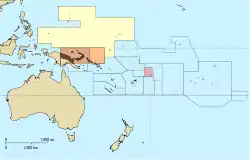
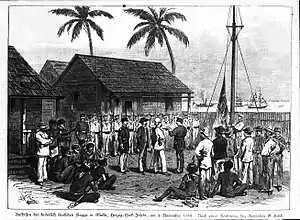
By the German–Spanish Treaty of 1899, Germany bought from Spain the Caroline Islands and the Mariana Islands (excluding Guam, which had been ceded to the US after the 1898 Spanish–American War) for 25 million pesetas (equivalent to 16,600,000 goldmarks). These islands became a protectorate and were administered from German New Guinea.[27] The Marshall Islands were added in 1906.
Forced labour policy
To expand the highly profitable plantations, the Germans needed more workers. The government sent military expeditions to take direct control of more areas from 1899 to 1914. Instead of voluntary recruitment it became a matter of forced mobilisation. The government enforced new laws that required the tribes to furnish four weeks of labour per person annually and payment of a poll tax in cash, thereby forcing reluctant local inhabitants into the work force. The government did explore the choice of voluntary recruitment of labourers from China, Japan, and Micronesia, but only a few hundred came. After 1910 the government tried to ameliorate the impact by ending the recruitment of women in some areas and entirely closing other areas to recruiting. The planters protested vehemently, deciding to go to war with the whites, and the government responded by sending 4 warships with 745 troops to defeat the Sokehs workers and impose the forced labour policy. They arrived in January 1911 and by February 1911 the Sokehs leader had surrendered.[28][29]
World War I
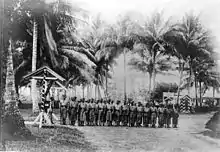
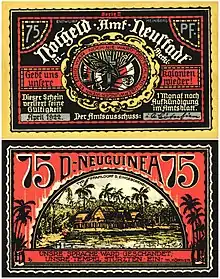
Following the outbreak of World War I, Australian troops captured Kaiser-Wilhelmsland and the nearby islands in 1914, after a short resistance led by Captain Carl von Klewitz and Lt. Robert "Lord Bob" von Blumenthal, while Japan occupied most of the remaining German possessions in the Pacific. The only significant battle occurred on 11 September 1914 when the Australian Naval and Military Expeditionary Force attacked the low-power wireless station at Bita Paka (near Rabaul) on the island of New Britain, then Neu Pommern. The Australians suffered six dead and four wounded – the first Australian military casualties of the First World War. The German forces fared much worse, with one German officer and 30 local policemen killed and one German officer and ten local policemen wounded. On 21 September all German forces in the colony surrendered.
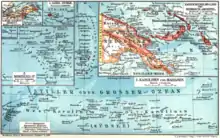
However, Lieutenant (later Hauptmann) Hermann Detzner, a German officer, and some 20 policemen locals evaded capture in the interior of New Guinea for the entire war. Detzner was on a surveying expedition to map the border with Australian-held Papua at the outbreak of war, and remained outside militarised areas. Detzner claimed to have penetrated the interior of the German portion (Kaiser Wilhelmsland) in his 1920 book Vier Jahre unter Kannibalen ("Four Years Among Cannibals"). These claims were heavily disputed by various German missionaries, and Detzner recanted most of his claims in 1932.
After the Treaty of Versailles of 1919, Germany lost all its colonial possessions, including German New Guinea. In 1923, the League of Nations gave Australia a trustee mandate over Nauru, with the United Kingdom and New Zealand as co-trustees.[30] Other lands south of the equator became the Territory of New Guinea, a League of Nations Mandate Territory under Australian administration until 1949 (interrupted by Japanese occupation during the New Guinea campaign) when it was merged with the Australian territory of Papua to become the Territory of Papua and New Guinea, which eventually became modern Papua New Guinea. The islands north of the equator became the Japanese League of Nations Mandate for the South Seas Islands. After Japan's defeat in World War II, the former Japanese mandate islands were administered by the United States as the Trust Territory of the Pacific Islands, a United Nations trust territory.
Territories
| Territory | Period | Area (circa) | Current countries |
|---|---|---|---|
| Kaiser-Wilhelmsland | 1884–1919 | 181,650 km²[31] | |
| Bismarck Archipelago | 1899–1919 | 49,700 km² | |
| Buka Island | 1899–1919 | 492 km²[32] | |
| Bougainville Island | 1899–1919 | 9,318 km² | |
| Palau | 1899–1919 | 466 km²[31] | |
| Caroline Islands | 1899–1919 | 2150 km²[33] | |
| Nauru | 1899–1919 | 21 km² | |
| Mariana Islands | 1899–1919 | 461 km² | |
| Marshall Islands | 1899–1919 | 181 km² | |
Planned symbols for German New Guinea
In 1914 a series of drafts were made for proposed coats of arms and flags for the German colonies. However, World War I broke out before the designs were finished and implemented, and the symbols were never actually put into use. Following its defeat in the war, Germany lost all its colonies, and the prepared coats of arms and flags were therefore never used.
 Proposed flag
Proposed flag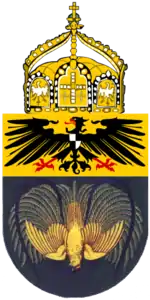 Proposed coat of arms
Proposed coat of arms
See also
References
- William Churchill, 'Germany's Lost Pacific Empire' (1920) Geographical Review 10 (2) pp84-90 at p84
- "Deutsche Südsee-Schutzgebiete: Deutsch-Neuguinea, Marianen, Karolinen und Marshall-Inseln" [German South Seas Protectorates: German New Guinea, Mariana Islands, Caroline Islands and Marshall Islands]. Deutsche Schutzgebiete (in German).
- Chronology of Germans in Australia Archived 30 November 2009 at the Wayback Machine
- Gutenberg Australia Abel Janszoon Tasman's Journal, edited by J E Heeres (1898), see descriptive note.
- Townsend, M. E. (1943) "Commercial and Colonial Policies" The Journal of Economic History 3 pp 124–134 at p 125
- Hans-Jürgen Ohff (2008) Empires of enterprise: German and English commercial interests in East New Guinea 1884 to 1914 Thesis (PhD University of Adelaide, School of History and Politics) at p 10.
- "Godeffroy and Son possibly controlled as much as 70 per cent of the commerce of the South Seas" Kennedy, P. M. (1972) Bismarck's Imperialism: The Case of Samoa, 1880–1890 The Historical Journal 15(2) pp 261–283 citing H. U. Wehler Bismarck und der Imperialismus (1969) pp 208–15; E. Suchan-Galow Die deutsche Wirtschaftstätigkeit in der Südsee vor der ersten Besitzergreifung (1884) (Veröffentlichung des Vereins für Hamburgische Geschichte, Bd. XIV, Hamburg, 1940).
- Romilly, H. H. (1887) "The Islands of the New Britain Group" Proceedings of the Royal Geographical Society and Monthly Record of Geography, New Monthly Series 9(1) pp 1–18 at p 2.
- Townsend, M. E. (1943) "Commercial and Colonial Policies" The Journal of Economic History 3 pp 124–134 at p 125.
- Hans-Jürgen Ohff (2008) Empires of enterprise: German and English commercial interests in East New Guinea 1884 to 1914 Thesis (Ph.D.) University of Adelaide, School of History and Politics p 26 quoting Schleinitz to Admiralty, 28 December 1875, Drucksache zu den Verhandlungen des Bundesrath, 1879, vol. 1, Denkschrift, xxiv–xxvii, p. 3.
- Hartmut Pogge von Strandmann, "Domestic Origins of Germany's Colonial Expansion under Bismarck" (1969) Past & Present 42 pp 140–159 at p 144 citing R. V. Pierard, "The German Colonial Society, 1882–1914" (Iowa State University, PhD thesis, 1964); K. Klauss, Die Deutsche Kolonialgesellschaft und die deutsche Kolonialpolitik von den Anfangen bis 1895 (Humboldt Universitat, East Berlin, PhD thesis, 1966); F. F. Müller, Deutschland-Zanzibar-Ostafrika. Geschichte einer deutschen Kolonialeroberung (Berlin (GDR), 1959).
- Hartmut Pogge von Strandmann, "Domestic Origins of Germany's Colonial Expansion under Bismarck" (1969) Past & Present 42 pp 140–159 at p 144 citing Deutsches Zentralarchiv Potsdam, Reichskanzlei 7158.
- Hans-Jürgen Ohff (2008) Empires of enterprise: German and English commercial interests in East New Guinea 1884 to 1914 Thesis (Ph.D.) University of Adelaide, School of History and Politics p 62. "It is the aim of this thesis to demonstrate that specific and identifiable commercial interests, rather than politicians, defence or strategic concerns, ideology or morality were the driving forces behind what did or did not happen in the first 50 years of European settlement in East New Guinea and adjacent islands." at p 10.
- Hans-Jürgen Ohff (2008) Empires of enterprise: German and English commercial interests in East New Guinea 1884 to 1914 Thesis (Ph.D.) University of Adelaide, School of History and Politics p 62-63 citing R. M. Smith (tr.) (1885) German Interests in the South Sea, abstracts of the White Book presented to the Reichstag, December 1884 and February 1885 and pinpoint reference 1884, Wb no. 19, p. 37; he adds "a full translation of Bismarck's speech was published by The Times on 25 June 1884 under the rubric 'German Colonial Policy', pp. 10–3."
- "German annexation of New Guinea". The Sydney Morning Herald. 7 February 1883. p. 4 – via National Library of Australia.
- Donald C. Gordon, 'Beginnings of an Australasian Pacific Policy' (1945) Political Science Quarterly 60 (1) pp 79–89 at p 84
- Donald C. Gordon, 'Beginnings of an Australasian Pacific Policy' (1945) Political Science Quarterly 60 (1) pp 79–89 at p 84 citing statistics from Queensland Legislative Assembly, Votes and Proceedings 1883 p 776
- Donald C. Gordon, 'Beginnings of an Australasian Pacific Policy' (1945) Political Science Quarterly 60 (1) pp 79–89 at p 85
- Donald C. Gordon, 'Beginnings of an Australasian Pacific Policy' (1945) Political Science Quarterly 60 (1) pp 79–89 at p 85 citing Queensland Legislative Assembly, Votes and Proceedings 1883 p 776
- William Churchill, 'Germany's Lost Pacific Empire' (1920) Geographical Review 10 (2) pp 84–90 at p 84
- I. M. Cumpston 1963 The Discussion of Imperial Problems in the British Parliament, 1880–85 Transactions of the Royal Historical Society, Fifth Series 13 pp 29–47 at p 42 citing Hansard, Parliamentary Debates 3rd Series cclxxxi 19
- P. G. Sack 'Finsch, Otto (1839–1917)' Australian Dictionary of Biography
- Peter By: Biskup, "Dr. Albert Hahl – Sketch of a German Colonial Official," Australian Journal of Politics and History (1968) 14#3 pp342-357
- Klaus-J. Bade. "Colonial Missions And Imperialism: The Background to the Fiasco of the Rhenish Mission in New Guinea," Australian Journal of Politics and History (1975) 21#2 pp 73–94.
- Hempenstall, Peter J. (1975). "The Reception of European Missions in the German Pacific Empire: The New Guinea Experience". Journal of Pacific History. 10 (1): 46–64. doi:10.1080/00223347508572265.
- Winter, Christine (2012). Looking after one's own: the rise of Nationalism and the Politics of the Neuendettelsauer Mission in Australia, New Guinea and Germany (1921-1933). Peter Lang Verlag. Details of table see page 26. This table is a selection of the most common names and variations used by archival documents and published sources for those mission societies which worked in the Bismarck Archipelago and Kaiser Wilhelmsland at the beginning of WWI. These missions were initially referred to by the Australian Administration as ‘German’ missions. Some of these mission operations in the field were, however, only loosely linked to Germany and German motherhouses. Some had a variety of transnational connections, especially to Australia, France, and Switzerland. Mission societies such as the Missionaries of the Sacred Heart were part of a wide family of related organisations and sub-organisations.
- Caroline Islands Timeline
- Firth, Stewart (1976). "The Transformation of the Labour Trade in German New Guinea, 1899-1914". Journal of Pacific History. 11 (1): 51–65. doi:10.1080/00223347608572290.
- Varnava, Andrekos (1 September 2015). Imperial expectations and realities: El Dorados, utopias and dystopias. ISBN 9781784997090.
- Hudson, WJ (April 1965). "Australia's experience as a mandatory power". Australian Outlook. 19 (1): 35–46. doi:10.1080/10357716508444191.
- "Rank Order – Area". CIA World Fact Book. Retrieved 12 April 2008.
- "Encyclopædia Britannica: Buka Island". Retrieved 22 September 2016.
- "The Pacific War Online Encyclopedia". Retrieved 22 September 2016.
Further reading
- Peter Biskup: Hahl at Herbertshoehe, 1896–1898: The Genesis of German Native Administration in New Guinea, in: K. S. Inglis (ed.): History of Melanesia, Canberaa – Port Moresby 1969, 2nd ed. 1971, 77–99.
- Firth, Stewart: Albert Hahl: Governor of German New Guinea. In: Griffin, James, Editor: Papua New Guinea Portraits: The Expatriate Experience. Canberra: Australian National University Press; 1978: 28–47.
- Firth, S. G.: The New Guinea Company, 1885–1899: A Case of Unprofitable Imperialism. in: Historical Studies. 1972; 15: 361–377.
- Firth, Stewart G.: Arbeiterpolitik in Deutsch-Neuguinea vor 1914. In: Hütter, Joachim; Meyers, Reinhard; Papenfuss, Dietrich, Editors: Tradition und Neubeginn: Internationale Forschungen zur deutschen Geschichte im 20. Jahrhundert. Köln: Carl Heymanns Verlag KG; 1975: 481–489.
- Noel Gash – June Whittaker: A pictorial history of New Guinea, Jacaranda Press: Milton, Queensland 1975, 312 p., ISBN 186273 025 3.
- Whittaker, J L; Gash, N. G.; Hookey, J. F.; and Lacey R. J. (eds.) : Documents and Readings in New Guinea History: Prehistory to 1889, Jacaranda Press: Brisbane 1975/1982
- Firth, Stewart (1973). "German Firms in the Western Pacific Islands". Journal of Pacific History. 8 (1): 10–28. doi:10.1080/00223347308572220.
- Firth, Stewart G.: German Firms in the Pacific Islands, 1857– 1914. In: Moses, John A.; Kennedy, Paul M., Editors. Germany in the Pacific and Far East, 1870–1914. St. Lucia: University of Queensland Press; 1977: 3–25
- Firth, Stewart (1985). "German New Guinea: The Archival Perspective". Journal of Pacific History. 20 (2): 94–103. doi:10.1080/00223348508572510.
- Firth, Stewart: The Germans in New Guinea. In: May, R. J.; Nelson, Hank, Editors: Melanesia: Beyond Diversity. Canberra: Australian National University, Research School of Pacific Studies; 1982: 151–156.
- Firth, Stewart (1976). "The Transformation of the Labour Trade in German New Guinea, 1899-1914". Journal of Pacific History. 11 (1): 51–65. doi:10.1080/00223347608572290.
- Firth, Stewart. Labour in German New Guinea. In: Latukefu, Sione, Editor. Papua New Guinea: A Century of Colonial Impact 1884–1984. Port Moresby: The National Research Institute and the University of Papua New Guinea in association with the PNG Centennmial Committee; 1989: 179–202.
- Moses, John, and Kennedy, Paul, Germany in the Pacific and Far East 1870–1914, St Lucia Qld: Queensland University Press, 1977. ISBN 9780702213304
- Sack, Peter, ed., German New Guinea: A Bibliography, Canberra ACT: Australian National University Press, 1980, ISBN 9780909596477
- Firth, Stewart: New Guinea Under the Germans, Melbourne University Press : International Scholarly Book Services: Carlton, Vic. 1983, ISBN 9780522842203, reprinted by WEB Books: Port Moresby 1986, ISBN 9980570105.
- Foster, Robert J. (1987). "Komine and Tanga: A Note on Writing the History of German New Guinea". Journal of Pacific History. 22 (1): 56–64. doi:10.1080/00223348708572551.
- Mary Taylor Huber: The Bishops’ Progress. A Historical Ethnography of Catholic Missionary Experience of Catholic Missionary Experience on the Sepik Frontier, Smithsonian Institution Press: Washington and London 1988, 264 pp., ISBN 0-87474-544-6.
- Mary Taylor Huber: The Bishops’ Progress: Representations of Missionary Experience on the Sepik Frontier, in: Nancy Lutkehaus (ed.): Sepik Heritage. Tradition and Change in Papua New Guinea, Crawford House Press: Bathurst, NSW (Australia) 1990, 663 pp. + 3 maps, ISBN 1-86333-014-3., pp. 197–211.
- Keck, Verena. "Representing New Guineans in German Colonial Literature," Paideuma: Mitteilungen zur Kulturkunde (2008), Vol. 54, pp 59–83.
